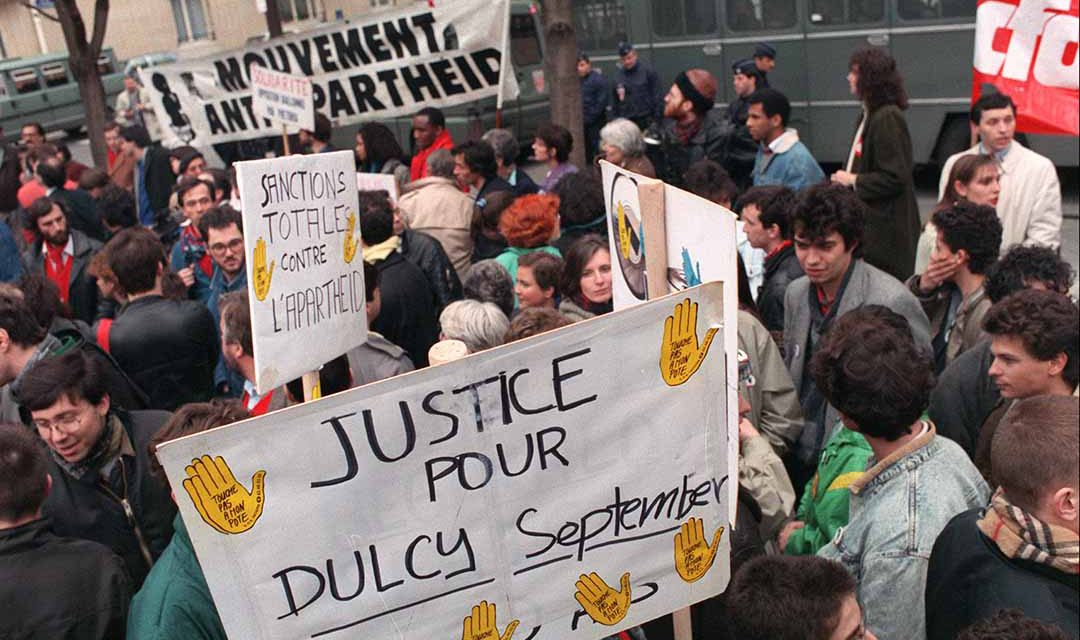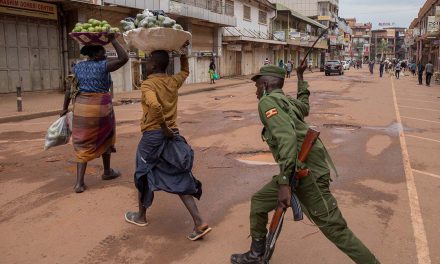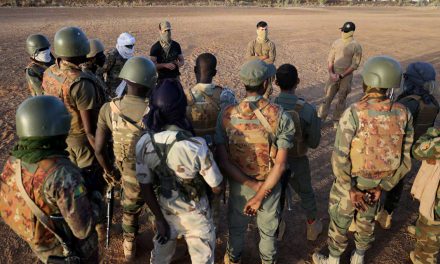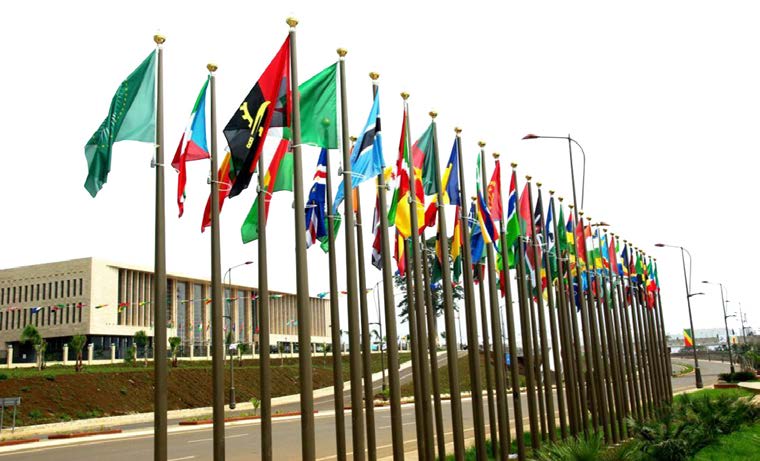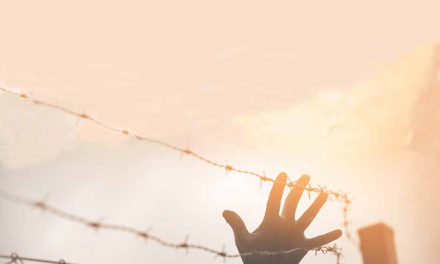South Africa and weapons: a dirty history
There is evidence that the motives for the murder of three prominent antiapartheid activists were much more complex than official narratives suggest
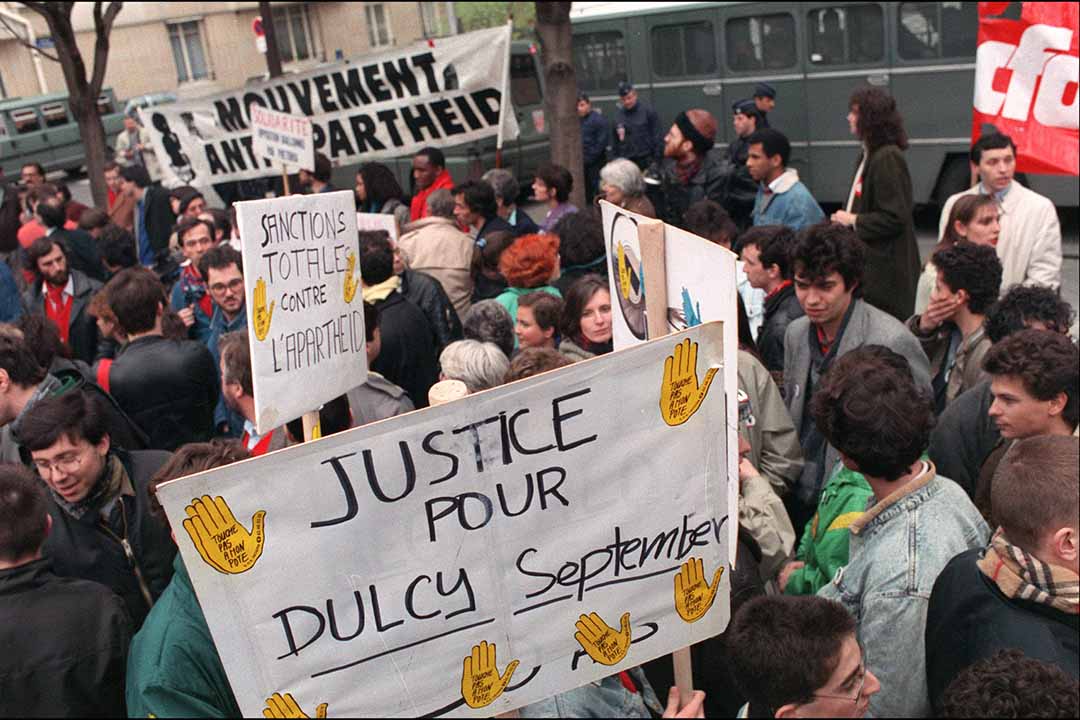
Protesters gather in front of the South African Embassy in Paris on 29 March, 1988 to protest against the assassination that day of Dulcie September, the African National Congress representative in France. Photo: YVES SIEUR / AFP
It is 29 March, 2018 in Arcueil, a grey suburb of Paris, France. About a hundred people have gathered under a white tent in front of a grey apartment building. It is raining and the recently scrubbed street under the tent roof smells heavily of Lysol (a cleaning and disinfecting product). Near the wall of the apartment building flowers are placed under a large portrait of Dulcie September. “Here lived Dulcie September, who was killed by apartheid,” reads a plaque on the same wall. In a few hours the mayor of Arcueil, an organising committee, and a representative from the South African embassy will highlight the misdeeds of the apartheid regime and the principled bravery of the late September, freedom fighter and representative of Nelson Mandela’s African National Congress (ANC). Thirty years ago, on 29 March, 1988, so the narrative goes, September was murdered by a racist death squad at the service of the aforementioned regime.
Today, ankle deep in puddles of rainwater mixed with Lysol, we are staying with that narrative. But it wasn’t “apartheid” that killed her, at least not in the way the accepted narrative suggests. September was killed to prevent her from publicly exposing information about – in the words of her then superior in the ANC, Aziz Pahad – “nuclear issues” involving France and South Africa. Before she was murdered she had been frantically calling on both the ANC head office in London and the World Campaign against Military and Nuclear Collaboration with South Africa, saying to the latter that she had information, and the former that they needed to come to Paris to help her confront a “sensitive matter”. It would take me seven years to find out that there were in fact nuclear issues, and quite a bit longer to come close to understanding how literally explosive these issues were.
My investigation into the nuclear trail began when a South African journalist told me, some time in 1989 or 1990, about advanced nuclear cooperation between France and South Africa. The nuclear collaboration itself wasn’t shocking – everyone knew France had helped build South Africa’s Koeberg nuclear reactor and was also routinely breaking arms sanctions. But a journalist at The Star newspaper, James Tomlins, told me about something very different: “The South Africans developed a small nuclear warhead,” he said. “It could fit on a missile and completely obliterate a relatively small area like a black township. The French wanted that, though I don’t know why. They were acquiring it in 1987.” Then, I doubted what he said, even if he was reputed to be very well informed. If true, it would mean that the nuclear military help the pariah nation received from France was frighteningly extensive, since South Africa would not have developed such things in isolation.
Had France and other western governments perhaps seen the police state as a friendly nuclear playground, with Pelindaba – South Africa’s main nuclear research facility – a place where one white power happily worked with the other for mutual benefit, far away from activists? I had hesitated to accept what Tomlins said – he was the only source for this. But Pahad’s statement, in 1995, when he told me Dulcie had “stumbled on nuclear issues”, confirmed it somewhat. As did a 1995 newspaper article in the South African Sunday Times that quoted “disgruntled Pelindaba scientists” who felt they were being abandoned by the government after having, they said, developed “modern thermonuclear” technology. This assertion was later also confirmed – albeit in extremely careful wording – in a book written, by the “godfathers” of South Africa’s nuclear programme, Hannes Steyn, Jan van Loggerenberg and Richardt van der Walt.
The small warhead Tomlins had spoken about fitted the description the scientists gave. I never found out how much September actually knew about these developments, but that she knew something is clear from Pahad’s comments. At the time, South Africa was a country under international sanctions; activists were even up in arms about Danish lumpfish caviar sales to the country. Imagine the fallout if Francois Mitterrand’s France had been exposed, then, as a partner and client of the pariah regime in the development of one of the most modern nuclear weapons in the world. It was in that context that my colleagues and I came to understand why rational individuals, from the French government and officials in the London ANC office to a new government in charge in Pretoria, needed to stick with the script: September was an ANC activist killed by an apartheid death squad. It’s nice, when in need of a cover up, to have a simple narrative at hand.
Even more so when it’s a simple “good versus bad” narrative. Which is probably why it took me so long to realise that what Tomlins had told me was very probably the truth. It would be at least another year before I was forced to admit that since no other struggle activist had ever been killed by an “apartheid death squad” in western Europe, they were either singularly ineffective or they were not there. The case of Anton Lubowski, the late lawyer and South West African People’s Organisation (SWAPO) activist and freedom fighter, has similarly been simplified. On 12 September, 1989 Lubowski was murdered after getting entangled – though he was largely unaware of this, I believe – in a web of shady contracts and intelligence services, which included the Sicilian mafioso Vito Palazzolo, the French secret service and the South African Directorate of Covert Collection. One of the last things he was overheard saying was that he “did not want to do all that these people (involved with diamond mining and casinos) asked of him”.
But those elements have, except from in my work, been removed from every single other narrative about his murder. His story remains tied, just like Dulcie September’s case, to an apartheid death squad with a one-dimensional motive. As a country, South Africa also sticks to the comfortable narrative that legendary ANC guerrilla commander Chris Hani was murdered on 10 April, 1993 by a white supremacist of Polish origin called Janusz Waluś, simply because he was a communist and black. A month after the rainy ceremony in Arcueil, in April 2018 – it was the 25th anniversary of the Hani assassination – South African newspapers reported that Waluś had once again been denied parole, reverting, also once again, to the lone white supremacist killer narrative.
Not even a week before, the same newspapers had published reviews of my book Incorruptible, which highlighted that Waluś’s address book had been full of secret service and arms trade contacts; that a second perpetrator was seen at the murder scene; that the area had been buzzing with military intelligence activity just before and after the murder and that the “eye witness” the state had relied on to pin the murder on Waluś had not even been there at the time. The context of the murder, which took place in the midst of the “buying up” of the erstwhile ANC army, Umkhonto we Sizwe (MK), by arms companies, British Aerospace in particular, had also been widely published by then. My book quoted fellow former MK soldiers who were convinced Hani had stood in the way of this “selling out” and that was why he was murdered.
Important ANC and MK leaders – notably later Minister of Defence Joe Modise – had been preparing a R60 billion (then $6 billion) arms deal at the time, with the lion’s share of this deal going to British Aerospace. The newspapers disputed none of this. Yet, in one week, the dominant narrative had snapped back again: Waluś was the sole Hani killer and we were now discussing the denial of his parole. The rest was forgotten. The narrative snaps back, again and again. It has happened in all three cases, and repeatedly, in the past three decades. State, or state-aligned institutions, don’t like to rock the boat when there are powerful interests to protect. For example, the South African Truth and Reconciliation Commission (TRC), which was established in the mid 90s and meant to unravel the legacy of apartheid atrocities, fired Swedish investigator Jan Ǻke Kjellberg after his work (which I assisted) on the September and Lubowski murders brought him close to people in the French government.
There was probably also a good reason why the TRC’s Chris Hani investigation was delegated to a singularly incompetent policeman from KwaZulu-Natal (Wilson Magadhla, who made no impression whatsoever other than in one of his reports, creating the immortal sentence, “The solution to these cases will only be found when these cases are solved”). If I have learnt any lesson in the past 30 years, it is that if an uncomfortable truth is not in an influencer’s interest to pursue, it will not be pursued. It may, therefore, be entirely up to those who associate ourselves with the fight for social justice and human rights to stop being satisfied with simple narratives that place us on the side of the good and give us an identifiable enemy at which to rage. Amilcar Cabral’s “claim no easy victories, tell no lies” may mean that we sometimes have to deal with an “enemy within”, as Dulcie September wrote in her last letter to her family.
Maybe society’s public debate bodies – the media predominantly among them, but also research institutes and scholars – should sit upright when evidence is unearthed that shows the complexity of power, of expensive projects, trade deals, corrupt states and failing governments. I am thinking of development aid here; I am thinking of Bill Gates and the African Union. Like stacks of dirty dishes in a neglected sink, you can ignore uncomfortable truths for a long time. And then you can, of course, bring out the Lysol when the cockroaches start crawling all over everything.
Investigative journalist Evelyn Groenink has spent 30 years on the quest to find out the truth behind the assassinations of Dulcie September, Anton Lubowski, Chris Hani and other southern African freedom fighters.
The following links provide pointers to some useful additional reading: https://www.amazon.com/Armament- Disarmament-Africas-Nuclear-Experience/ dp/0595356656)
Incorruptible: https://www.amazon.com/ Incorruptible-Murders-Dulcie-September-Lubowski/dp/0639926800 https://www.zammagazine.com/chronicle/ chronicle-0/9-dulcie-hani-lubowski-a-storythat- could-not-be-told
Evelyn Groenink is an investigative journalist, editor and author based in South Africa. She has published several books, most recently Incorruptible, on the murders of anti-apartheid activists Dulcie September, Anton Lubowski and Chris Hani. Her journalistic and editing work can be seen on www.zammagazine.com.

